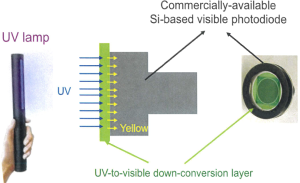BACKGROUND
Ultra-violet (UV) photodetectors have broad applications in many areas such as scintillator light detection, time correlated photo-detection, ultra-fast fluorescent microscopy detection, and ultra-dense spatial imaging. While Si-based photodiodes are fully commercialized with a variety of applications even including single-photon avalanche photodiodes (SPADs) which offer low dark count rates, high detection efficiencies and high-count rates in the visible to near-infrared range. In the UV range, however, the penetration depth of UV light in Si is typically only a few nanometers and thus absorption occurs before the UV photon reaches the detection region in the Si-based photodetectors. As a result, traditional Si-based photodetectors show poor performance in UV regions.
SUMMARY OF TECHNOLOGY
Researchers at OSU have conceived an Si-based UV photodetector design which extends the detection region to UV wavelength in current Si-based photodetectors. An efficient UV-to-visible down-conversion layer is employed, converting the absorbed UV light to visible light; then the down-converted visible lights will be absorbed by the Si-based photodetector. The Si-based photodetectors will not absorb any UV lights directly, thus eliminating surface recombination issues which cause insufficient carrier collection. This novel detector approach will make a compact, low-cost, high-resolution, and high efficiency UV photodetectors and sensors.

POTENTIAL AREAS OF APPLICATION
- UV photodetectors/sensors
- UV SPADs
MAIN ADVANTAGES
- Low-cost
- High-resolution
- Reduced noise
- High efficiency
STAGE OF DEVELOPMENT
Proof-of-concept